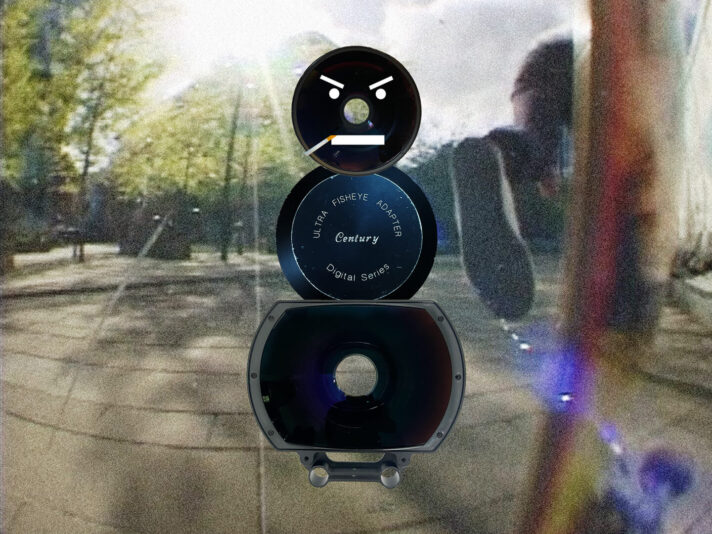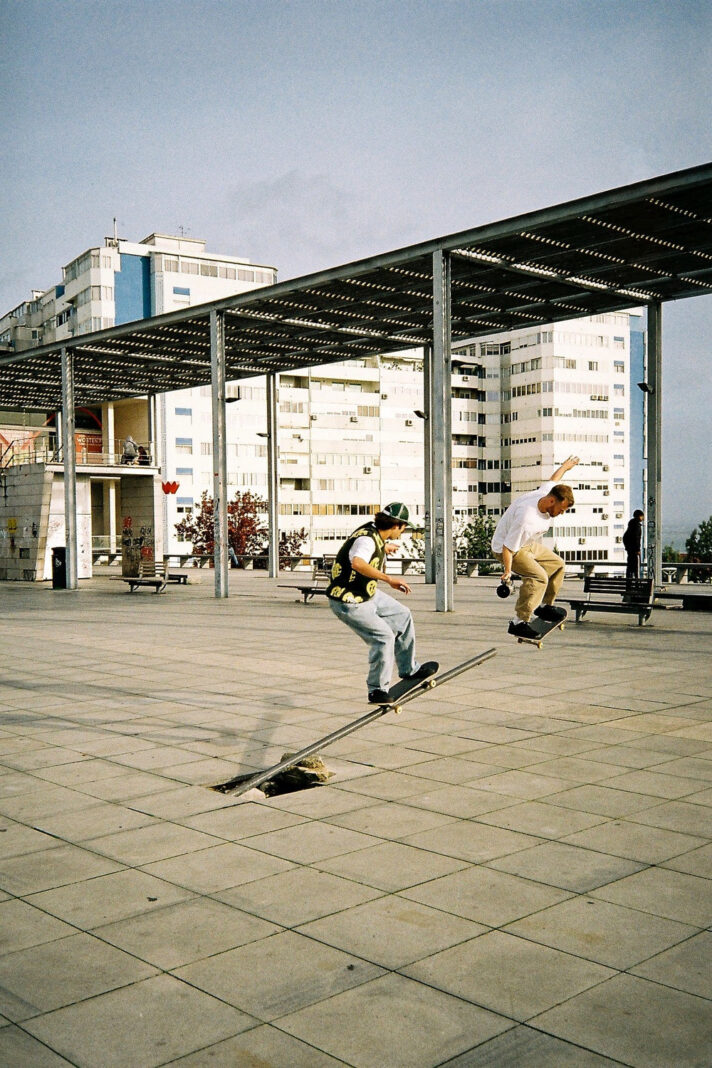📝 Words, Interviews & Top Graphic by Farran Golding
Skateboarding found its first industry standard filming rig when the Sony DCR-VX1000 video camera was paired with a Century Optics MK1 fisheye lens in the late 1990s. Fundamental to producing every tentpole skate video throughout the early 2000s, a precedent for skateboarding’s visual language emerged and footage captured through a fisheye lens became the defining trait of skateboarding cinematography.
Eventually, Panasonic HVX and HPX cameras equipped with an Xtreme fisheye succeeded the VX and MK1. Popularized by William Strobeck during the mid-2010s, this change of filming set-up coincided with long lens videography becoming the zeitgeist. Observing the Quartersnacks Top Ten (our closest thing to a longstanding data set) evidences a decline in fisheye use over the past decade.
Four weeks worth of the #QSTOP10, at four year increments, were studied discounting phone-captured footage and intro clips. Beginning with the format’s debut on July 15th, 2016 up until the installment of August 5th, 2016, the first month of #QSTOP10 featured an almost even split of 47% long lens to 53% fisheye footage. Across a comparative period in 2020 fisheye clips only dipped to 44% of the stocktake. Whereas in a relative timespan from mid-July to early August 2024 — when the majority of this story was written — long lens footage encompassed 70% of the #QSTOP10. Perhaps this scarcity of fisheye filming is why today, when handled with a certain deftness or sense of danger, the medium feels particularly standout.
I consulted a handful of adept videographers to discuss the intricacies, perils, and resonance of footage captured through a fisheye lens, circa 2024. Our panelists are Quentin Guthrie, a London-based cinematographer from Perth, Australia whose fluidly kinetic projects have been regular inclusions to Monday Links for some years now. Joining him is Chris Gregson, pro skateboarder for Blood Wizard and a videographer for Thrasher, renowned for follow-filming on transition and vert. We have the cine-literate Zach Sayles, based in Philadelphia, who produced the ethereal indie videos, Vanish (2019) and Veil (2023). Finally, we even got a few words out of Gustav Tønneson, the swift-footed Sour Skateboards pro with a double life as the brand’s director of photography.
“Good fisheye filming should represent how the trick felt and long lens doesn’t show that very well.” — Quentin Guthrie
When did you gravitate towards fisheye footage as a viewer and a videographer?
Quentin Guthrie: I think the east coast popularized super close-up fisheye filming. Big videos, personally, were the Static series — Static III specifically, Jeremy Elkin’s Poisonous Products, and Yoan Taillandier’s MINUIT. I think the earlier influences of that approach comes from Japanese skating, like the LENZ videos, which were at the forefront alongside Josh Stewart. To me, it’s developed from there and made its way to Europe.
When I started my YouTube channel in 2012, I put out a couple of edits, “BDP” and “1995.” I became more confident filming fisheye and tried to take a more cerebral approach, thinking about movement and the best way to represent a trick to show the speed, style and execution. Good fisheye filming should represent how the trick felt and long lens doesn’t show that very well.
Chris Gregson: I made a homie video called Lawless (2014), which Transworld hosted, and there was a follow line at Washington Street of Mason Merlino. I didn’t think twice of it. Washington Street is pretty spread out and there are a lot of blind spots. In my head, the only way to film the tricks in a row was to follow him. Lawless came out and Cole Matthews at Element, who now is my boss at Thrasher, hit me up. He wanted me to film Greyson Fletcher’s “In Transition” and the entire part as I had that line at Washington Street. I never saw anything special in it, I was just filming a line from A to B. I wouldn’t say it “blew up,” but people were hyped on the filming.
Afterwards, Cole wanted to put me on a small retainer just to film Greyson. He helped guide me and made me understand I was doing something unique. So I was like, “Fuck it, I’ll run with it.”
Zach Sayles: Pretty early on, around when I got my VX1000, the MK1 was the final piece. The first person I saw pushing [what you could do with] fisheye filming was Cooper Winterson. He would get incredibly close, almost under the board. The running joke with my friends was calling that “Cooping,” which made a clip all that much better.
As I got older and my filming style progressed, I saw Josh Stewart’s work. These days, I take on a lot of his front angle filming, but around when I was 20, the Lurk NYC videos started coming out. I would dissect Nick Von Werssowetz’s filming, he would push in as the skater approaches then pull out to see the whole spot. Also, Ryan Garshell [of GX1000], holds the camera in a simplistic way, an angle that captures the skating, which has its own identifiable look whether it’s VX or HPX. I remember early Magenta videos by Zach Chamberlain like Old Woops New Groove (2013); I watched that as a kid and was flabbergasted at how he would follow someone down, up and curving around hills while stepping off his board and throwing back down. It was seamless and framed perfectly while going fast as fuck.
When I started filming, I was copying one style specifically. Then I found a bunch of people who I was inspired by and tried putting it all together in a way which worked for me.
Gustav Tønneson: I’m still learning. I started filming in 2015 and it took me more than a year to be “good” at it — to get to the point where you don’t need to think where you’re pointing the camera. When we made The Sour Solution II, I got comfortable enough to do more advanced stuff like picking up my board mid-line, jumping over something, and getting on my board again.
How does the design of your preferred camera inform your approach to filming fisheye lines?
Chris: I want the smallest, lightest camera with the highest quality. A DSLR was the standard for what I wanted to do and then the RED Komodo came out two years ago. It was the first cinema camera I could use for the way I film. Since it’s in my front hand, if I’m rolling into a bowl and the camera’s too heavy, it’ll pull me forward. I’m goofy and I hold the camera with my right hand, which benefits me as I naturally reach forward. For anything hectic, like ollieing the channel with Tony [Hawk], I switch the camera into my back hand. You need your front arm to guide you and turn your shoulders.
Quentin: I modded an MK1 [fisheye] onto the HPX170, which I film with like a VX — in that I never use the flip out screen for lines. It’s all based on instinct, but has the benefit of being able to watch it back between attempts and analyze footage. It has improved my filming; you learn from your mistakes better that way. The camera is slightly heavier [than a VX], but that almost makes it easier to keep it steady. I can’t imagine filming without a handle on a camera though.
Gustav: I’ve only used the VX1000 with an MK1 so that’s all I know. I can’t imagine a lighter or heavier, bigger or smaller camera would be better.
Zach: The VX is compact, so you’re able to get close and maneuver with control. Whereas filming lines with a HPX and Xtreme fisheye, the weight almost took me off in a direction to the point where I had to, like, fight back. People are super wary about not playing footage back on the VX, but I’ll play back the first thirty attempts and check in every now and then. You only get lucky once. No matter how skillful you are, there’s a lot of luck involved with landing a trick. In the same way, there’s a lot of luck with filming.
“I have longer-term injuries from filming lines than I do from skating my whole life.” — Chris Gregson
Filming fisheye is a strenuous process. How does the physicality factor into your relationship with it?
Chris: My front knee is fucked because all the weight is on your front leg where the camera is, and your back leg is [used] to turn, slow down or push. Skating normally, your weight is evenly distributed or on transition you’re more in the backseat. When I’m follow-filming on a trip where there’s, like, eight people and I’m doing it all day, every day for a week — then all I’m doing is pumping through transitions as fast as I can to keep up.
The ligaments in my knee are destroyed. It pops in and out in my sleep. I had it checked out and, basically, they described the ligaments as those six-pack things cans sit into which you should recycle. When you’re born, they’re tight but they don’t make their shape back. The ligaments are completely stretched out, not torn, but there’s not any way to tighten it back up unless I get reconstructive knee surgery. I’m not going to do that, so I’ve suffered through it.
Zach: Luckily, I haven’t had any lasting effects, but in the moment, it can be gnarly. I remember filming a line where the obstacles were so close to one another that I had to run the whole thing and it took the skater three or four hours. I’ve had tons of camera hits. The amount of times I’ve been punched by someone as they’re ollieing or they’ve hit the top of my head happens so often it’s funny.
It’s more fun to film fisheye. Although, maybe due to the amount of time I’ve spent filming [VX], I’m a little weary of it. If the spot warrants a fisheye clip, or I can film it a certain way which will look cool, then I’ll break it out. Knowing how strenuous it can be, I’ve started to ease off of it a little bit.
From briefly using the HPX and Xtreme, I instantly could feel something in my back getting overworked. I can understand why people wouldn’t want to film a fisheye line with that setup. The camera itself is fairly light but the Xtreme is like putting a five pound weight on the front. I feel like you could damage your body trying to hold that, pointed up, while bent over.
“There will be a time when we look back nostalgically on HD long lens and consider how it was such a thing that almost took the fisheye out of the game.” — Zach Sayles
Has the uptick and standardization of long lens videography out there crept into your own work or pushed you further towards fisheye as an antithesis?
Zach: There was a point in making Veil where there was so much long lens going on [in skateboarding] that I changed the way I was filming. VX is tricky anyway, but with HD, you can sit in the right spot and footage looks good as the skater is flying by. Now, people have like figured out different ways to do that without it looking the same as Strobeck. Like being super zoomed out but [stood] close or right next to the skater rather than far away, incredibly zoomed in. Chase Walker does that and it looks cool.
Fisheye is the staple. I think even people who don’t skate would associate the fisheye lens with skateboarding. It’s timeless, but there’s such a look to HD long lens. With the VX, there was never really an emphasis, but the HPX has made it a specific way of filming.
Quentin: I think people are heavily influenced by Strobeck and the Supreme videos because he was one of the first people to use a HD camera and make it interesting with the long lens. “cherry” is one of the best videos ever made because it was a good combination of Strobeck’s close up [long lens] filming, but there was a lot of fisheye and lines. It was super refreshing.
I’d be lying if I said [Wilson and Strobeck] hadn’t influenced how I film long lens. With a HPX it’s hard not to mimic that style. I do yearn to see more lines in videos, but fisheye has always been my “gimmick.” That’s where I get the most satisfaction, so that’s what I focused all my energy on throughout my career. But I’m 32, so that’s probably considered an “old head” take.
Is there a link between being good at skateboarding and being a more daring filmer?
Quentin: For sure, it all comes down to control. You’re more likely to experiment if you feel comfortable on a board. That’s why Gustav [Tønnesson] is a good example. He picked up filming quickly and you can tell it’s because he’s so good at skating. Nowadays, a lot of my favorite filmmakers are good skaters as well. Gustav, Geoff Campbell, Ben Chadourne: I feel like “good” skaters make the “best” filmers. Also, it’s better to have that history because then you’re more realistic about what’s possible, you understand how a trick works and where you need to be to film it.
When I moved to the U.K., I linked up with Jacob Harris and I had never seen him skate before. One of the first times we met up, he almost did a heelflip backside noseblunt at Fairfield Halls. It was shocking to see someone that good at skating dedicate their time to filming.
“When there’s fifty grand on the line the pressure of not wanting to fuck someone up is pretty gnarly.” — Chris Gregson
Chris: Follow-filming is a huge trust thing between the skater and I. Being “good” at skating allows the skater to trust I’m not going to fuck them up. Especially in contest scenarios like the X Games.
Cameras and lenses are expensive, and fisheye filming puts your gear at risk. If you’re filming a skater for their sponsor’s project, should a brand compensate a videographer if something is broken?
Quentin: I think they should, especially corporate shoe brands, but understandably, the way I film is pretty high risk. If you’re holding a fisheye that costs $2000 an inch away from someone’s board and it gets scratched then who’s really to blame? [Ed. note: the MK1 generally costs upwards of $1000 and the Xtreme clocks in around $8000.]
My approach is to really put the camera into the board as someone is doing a trick to add the extra element of speed and make it more dynamic. For tricks that feel extra risky, I’ll use one of those Tadashi filters or I actually have a second MK1, which is more scratched and beaten up, but you can’t really see it in certain lighting, so I’ll work around it like that.
It’s quite humbling when you’re the one skating. I had it recently with a friend [filming me] really close and I was like, “Holy shit, this is so hard.” The videographer is basically just in the way, so I have a lot of respect for skaters who can put up with my type of filming.
“When you’re following the skater, physically trailing them, there’s a skill that goes into that. It feels like you’re both getting the clip.” — Zach Sayles
Filming a fisheye line is collaborative and hard work on both sides of the camera. How do you feel about the camaraderie it creates between the skater and filmer?
Quentin: I’m lucky to film with people who have an appreciation for what I’m trying to achieve like Dougie [George], Charlie [Munro], Davide [Holzknect] and Dan [Fisher-Eustance]. Because we have that connection, it’s a lot more fun to film a line; it feels more satisfying in the end. When I’m filming a line that starts with a flatground trick, if they take a slam it almost feels like I’m taking a slam because I’m so invested in the outcome.
Chris: I translate skating to filming. I want to push myself [filming] like how you want to skate better with every video part. That’s what I like so much about follow-filming: I truly get scared. I get the same feeling and emotions as when I’m the one trying a trick.
Gustav: I usually do a follow test with the skater to see how the line goes and figure out where to be at different points. I’ve also suggested a skater to do this or that to make the line work better. I also notice a difference depending on the filmers when I’m the one skating. Filming with Fritte [Söderström] is more complicated in a positive way. It takes more planning and practice when being filmed from the front, which he does a lot.
Zach: When a skater lands their trick, you film it exactly how you wanted, and they do it exactly how you wanted them to — it’s much better than being sat there long lens. It’s more of a celebration. It feels like you’re both getting the clip.
“Following Simon Isaksson down a multi-kink bank … I wouldn’t have done that more times than absolutely needed.” — Gustav Tønneson
In situations where you want to ask a skater to re-do a trick, does filming it fisheye alleviate some of the tension because you’re also committing to putting yourself through it again too?
Quentin: I have a reputation of being a bit of a nightmare. I don’t mind creating tension if it means we get the right outcome, but it all depends on the context [of what has gone into the trick].
Gustav: The only thing that comes to mind is following Simon Isaksson down a multi-kink bank in The Sour Solution II, I wouldn’t have done that more times than absolutely needed. I don’t want to think about what would’ve happened if he had fallen in front of me as we were getting towards the bottom of the banks.
Zach: I’ve asked people to re-do a trick that I didn’t film properly — or how I wanted to — even though they thought it looked good. I’ll feel so terrible. If someone falls after they’ve already done the trick, every time they go back to the start, I’m sheepishly, like, “Dude, I’m sorry. You can stop.” I’m close friends with people I film with, so if someone eventually says “Fuck this,” it’s completely fine. I’ve been less nit-picky, as things have gone on. I know how hard it is to skate Philly and I don’t want to have to make someone do it again if it really doesn’t matter.
Chris: I always have an expectation of how I want the line to look. If it somehow doesn’t turn out that way, and I think that the skater can do it again — easily — I’ll ask for sure. If it’s something they battled for hours and it was super hard for them, then I’m going to take the “loss” and be like, “Damn, I kinda blew it, but whatever.”
Filmers are their own worst critics. If the skaters are hyped on it, then that’s all that matters. Our job is to keep them hyped, keep them skating, and keep their sponsors happy. We wouldn’t be here if it wasn’t for the skaters. As long as they’re stoked, I’m stoked. I don’t get bummed on myself. I just think, “I’ll film the next one better.”








Awesome article! I’m sad to see fisheye fading out, but understand how the industry is so tied to the hpx/hvx and that too damn expensive fisheye. There’s other options, but it feels like the vx/mk1 all over again. I hope to see more people branching out to other cameras soon, but who knows (also, maybe they are? I’m old and kind of out of touch)
Also, gotta give props to the best vx/mk1 filmer I know – Jordan Sanchez. He really knew that lens, check out vics market on youtube.
Great article, thanks for putting in the time and effort on this one. Quintin is one of my favorite filmers/video dudes for sure and it was a bummer to see the switch from VX but 4:3 HD with the MK1 might be the future.
Can’t see comments at the bottom of the posts anymore
Can only see comments at the bottom of the post after I made a comment? Am I going crazy?
that Christian Dufrene part had some really good canon 8-15 fisheye clips
The words ” wary” and “weary” used correctly in the same article in 2024 is an amazing thing to see